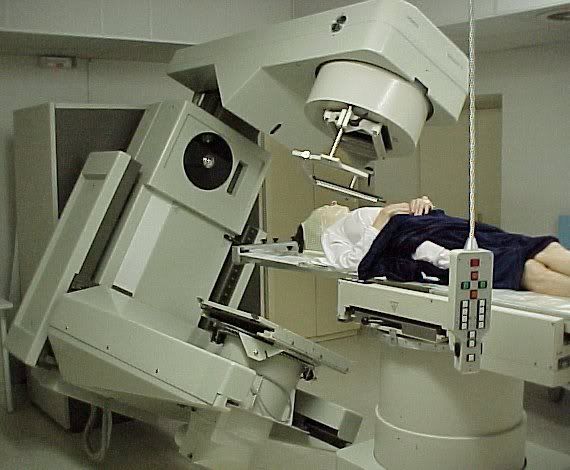Clinical pharmacokinetics of erlotinib in patients with solid tumors and exposure-safety relationship in patients with non–small cell lung cancer.
Erlotinib (Tarceva [OSI-774]; OSI Pharmaceuticals, Melville, NY, and Genentech, South San Francisco, Calif) is a potent and highly selective inhibitor of epidermal growth factor receptor (EGFR) tyrosine kinase. At nanomolar concentrations, erlotinib inhibits EGFR-dependent proliferation of tumor cells in vitro and blocks cell-cycle progression in the G1 phase. EGFR is highly expressed in a wide spectrum of tumors, such as head and neck, breast, brain, lung, cervical, bladder, gastrointestinal, and renal tumors, as well as other epithelial malignancies, and is a rational strategic target for anticancer therapy. Erlotinib is indicated for the treatment of patients with locally advanced or metastatic non–small cell lung cancer (NSCLC) after failure of at least one prior chemotherapy regimen and was recently approved for use in combination with gemcitabine chemotherapy for treatment of locally advanced, inoperable, or metastatic pancreatic cancer.
Erlotinib is extensively metabolized. In vitro studies in human cells have shown cytochrome P450 (CYP) 3A4 and CYP1A2 to be the hepatic enzymes involved in the formation of the major metabolites. Extrahepatic metabolism by CYP3A4 in the intestine, CYP1A1 in the lung, and CYP1B1 in tumor tissue might also occur. About 95% of erlotinib in plasma is protein-bound. The pharmacokinetics of erlotinib from a phase 1 dose-escalation study was published. The apparent clearance (CL/F) and volume of distribution were 6.3 L/h and 136.4 L, respectively. The steady-state concentration (Css) was 1200 ± 620 ng/mL. A mean half-life of 24.4 ± 14.6 hours was documented.
Rash and diarrhea have been the primary adverse effects of treatment with small-molecule EGFR inhibitors and are presumed to be caused by biologic activity of these agents in normal EGFR-expressing tissue. Early in the clinical development of erlotinib, a potential correlation between the development of rash and improved survival rate was observed in nonrandomized trials. In a preliminary population pharmacokinetic (PK) and exposure-safety analysis, patients with higher free erlotinib exposure early in their treatment course had a more rapid development of rash.
DISCUSSION
One clinical utility of population PK modeling is to gain insight as to which, if any, special patient populations may require dose modification to avoid toxicity or a compromise in efficacy. Among all covariates tested, AAG and TBIL were the covariates most critical to explaining interindividual variability for CL. The final model for single-agent erlotinib treatment predicts that patients with high concentrations (95th percentile) of AAG (2.3 g/L) or TBIL (1.1 mg/mL) would have CL/F decreased by 31% and 30%, respectively. The decrease in CL/F associated with high AAG levels is consistent with the extensive protein binding of erlotinib (92%-95%). As AAG levels increase, CL/F decreases, resulting in an increase in erlotinib levels. However, because levels of both erlotinib and AAG increase, the unbound erlotinib fraction should not change significantly and the clinical consequences would be expected to be modest.
The mechanistic basis for the relationship between bilirubin and erlotinib CL/F is less clear. Bilirubin is not expected to affect the metabolism of erlotinib through enzyme uridine diphosphate–glucuronosyltransferase 1A1 because erlotinib is first metabolized by phase 1 metabolizing enzymes (O-demethylation, acetylene oxidation, aromatic hydroxylation) with subsequent phase 2 conjugation of metabolites. In vitro, erlotinib has been shown to alter uridine diphosphate–glucuronosyltransferase 1A1 glucuronidation of bilirubin (data not shown). It is possible that higher bilirubin levels reflect an erlotinib concentration–dependent effect on its metabolism; that is, high erlotinib concentrations result in high bilirubin concentrations. However, the plot of the baseline level of TBIL versus CL and a separate analysis (data not shown) with baseline TBIL did suggest that high TBIL is correlated with slow clearance of erlotinib.
Although, at the higher range of serum bilirubin levels tested, an overall 30% decrease in clearance is predicted, the clinical relevance of this effect would be small because the severity of rash or diarrhea grade does not appear to correlate strongly with drug exposure. These data support current prescribing recommendations not to reduce the erlotinib dose in patients with modest elevations in bilirubin concentrations, with subsequent clinical management consisting of 50-mg dose reductions or treatment interruptions for intolerable toxicity.
The result of smoking effect on clearance is consistent with in vitro data showing the potential induction of CYP1A1 and CYP1A2 enzymes by smoking and suggests that these enzymes may play a role in the metabolism of erlotinib clinically. A recent healthy volunteer study confirmed the smoking effect and showed that smokers require a higher dose, 300 mg, to achieve drug exposure similar to that in nonsmokers taking 150 mg erlotinib. Interestingly, in BR.21 an enhanced benefit for persons who never smoked (hazard ratio, 0.42) was observed as compared with all patients (current smokers, former smokers, and those who never smoked), who have a survival benefit hazard ratio of 0.71.7 However, further analysis revealed that, although there were significant differences in drug exposure between current and former smokers, there was no significant difference in their survival benefit. Therefore a greater survival benefit in those who never smoked relative to smokers (current and former) may reflect underlying differences in the biologic characteristics of the disease in these 2 subpopulations rather than PK exposure. Currently, there are no recommendations for dose escalations in smokers, in part given the similar survival benefit between the current smoker and former smoker groups, despite predicted differences in drug exposure. However, appropriate dosing in active smokers is an ongoing area of clinical research.
The effects of chemotherapy agents on erlotinib clearance are considered to be small, given its small magnitude and large SE (more than 44%) for the estimates. The results are consistent with the lack of a significant effect of these combination chemotherapies observed in the intensively sampled substudies of the phase 3 studies. It is not clear whether the small increase in clearance in combination studies is a result of the difference in patient population or a different compliance pattern between single-agent treatment and combination treatment. Despite the fact that the significant drug-drug interaction was observed when erlotinib was administered with the CYP3A4 inhibitor ketoconazole or inducer rifampin (INN, rifampicin), these effects were not detected in the analysis, which reflects the limitation of using population PK analysis to evaluate drug-drug interactions. Among the possible reasons are the lack of detailed documentation regarding the specific inhibitors or inducers used, the timing of their administration in relation to the concentration samples, or the effects of other concomitant medications.
The dose-limiting toxicities of small-molecule inhibitors of EGFR include those predicted on the basis of inhibition of the target receptor expressed on normal tissue and are primarily rash and diarrhea. Interestingly, the clinical data reported thus far for erlotinib and other EGFR inhibitors for various indications and in different clinical settings support a correlation between rash and survival rate. The reasons for these differences are not clear, but they could be a result of different dosing strategies or PK or pharmacogenetic heterogeneity among patients.
Preliminary data from a phase 2 study of single-agent erlotinib in heavily pretreated metastatic breast cancer patients in whom PK sampling was performed for population PK analysis suggest that the extent of drug exposure is related to both time to onset and severity of rash. In this analysis a statistically significant correlation between exposure and severity of rash was observed. However, on the basis of the low correlation coefficient and significant overlap in the range of values for patients who had no toxicity (grade = 0) and those who had any grade of toxicity, the correlation does not appear to be of sufficient magnitude to be considered relevant. More studies are required to understand whether rash predicts outcome with EGFR-targeted agents and whether prescribing doses to patients until rash occurs will result in a survival benefit.




0 Comments:
Post a Comment
<< Home